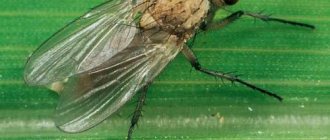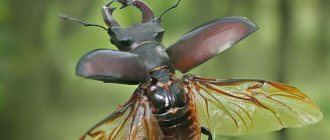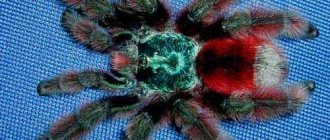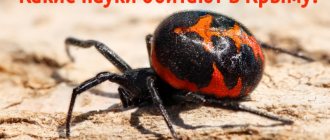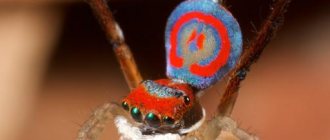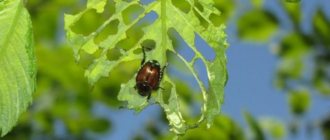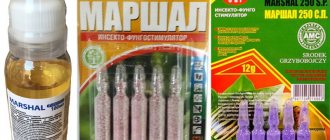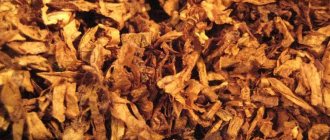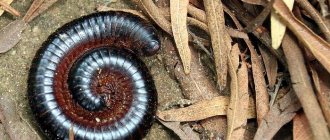To get a big harvest, it is not enough to choose a good variety, follow the rules of agricultural technology and carry out disease prevention. Considerable damage to plants is caused by earthen pests, which are practically invisible, and this complicates their detection.
They cause more problems than terrestrial insects, since the root system and base of the stem suffer. If they are damaged, it is almost impossible to save the plant.
Most often, damage to the garden, vegetable garden and flower beds is caused by insects - mole crickets, wireworms (larva of the click beetle), beetles (larva of the May beetle), root nematode, gnawing cutworm, carrot and onion flies. Moles, mole rats, shrews, earth rats and mice are not far behind them in terms of wrecking activity. Each of them has their own habits and taste preferences. Therefore, to fight effectively, you need to know everything about them.
The mole cricket is a species of orthopteran insect. Its body is brownish-brown, quite large in size (up to 5 cm), completely covered with small hairs. This pest quickly breaks through tunnels in the upper layers of the soil. It rarely crawls to the surface, mainly at night.
The mole cricket prefers moist soils rich in humus and humus, well warmed by the sun. Its appearance can be evidenced by winding, loosened ridges of earth, as well as plants that begin to rapidly die for no apparent reason.
Insects overwinter at a depth of 60 cm; they often gather in compost heaps. In the spring they mate, in the summer they make nests at shallow depths, where the females lay hundreds of eggs (on average 600-700 eggs). The larvae grow for about 2.5 years before becoming adults.
The mole cricket tops the list of soil pests, which is not at all surprising. She is a polyphage. That is, it harms not only root crops and potato tubers. This insect can destroy almost any plant - corn, tomatoes, cucumbers, peppers, eggplants, melons - everything that comes its way. It damages crops of grain and industrial forage crops, feeds on the roots of young fruit trees, berries and ornamental plant species. She eats everything - seeds (sown grains), shoots, plant roots. However, the bear is far from a vegetarian. It does not disdain earthworms, soil invertebrates and many small insects.
Colorado beetle
The Colorado potato beetle is one of the most dangerous pests of nightshades. Potatoes, tomatoes, eggplants, fragrant tobacco, and wild nightshade suffer the most. There is information that sometimes the Colorado potato beetle can feed on the leaves of sweet pepper, physalis and wolfberry. Its homeland is northern Mexico, from where it spread to North America, and at the end of the 19th century to Europe. At first, the outbreaks were quickly eliminated, but during the First World War it spread throughout France, from where it began to spread throughout Eurasia. Since 2000 it has reached the Primorsky Territory.
An adult Colorado potato beetle is an insect up to 12 mm long and up to 8 mm wide. Its distinctive feature is 5 black longitudinal stripes on each wing. The pronotum is orange with black spots.
The first, yellow eggs, does not threaten the plant in any way. They are laid on the underside of the leaf of female insects immediately after potato tops or tomato seedlings or eggplants are planted in the ground. After a couple of weeks, larvae emerge from the eggs. They begin to quickly feed on nightshade leaves, turning bright orange or pink in color and gaining mass. The color depends on carotene, which accumulates in the body of the larva without being digested. The head of the larva is black, the same points are located longitudinally along the back in two rows.
In its development, the larva goes through 4 stages, molting after each of them. In the first stage they feed on part of the leaf from below, in the second they eat the entire leaf, leaving veins. They then climb onto other stems or bushes in search of food. After 2 weeks, the larvae burrow into the ground to a depth of 10 cm. There they turn into a pupa and after a couple of weeks they can emerge as adults. A new cycle of reproduction and development begins. Depending on the climate, there can be up to three such cycles. The further north the region, the fewer generations will appear per year. An adult Colorado potato beetle or pupa overwinters in the ground. Not afraid of frost. It can enter diapause without dying if conditions are unfavorable for it.
The horde of larvae leaves virtually no chance for nightshades to survive. Therefore, you need to fight it regularly:
- The most reliable are plant treatments with insecticides. You can fight them by laying out traps and collecting adult beetles every day, and then larvae, if there are a couple of acres of potatoes on the plot. But unforeseen circumstances may prevent you from doing this for several days in a row. This time will be enough for the beetles and larvae to eat all the tops. The beetles are collected in a deep bowl with a strong solution of salt or kerosene. This is an extremely unpleasant task.
- A week before harvesting potatoes, it is recommended to cut off the tops. Young larvae may die without food. But this will happen only when there is no food nearby - tomatoes, eggplant. In this case, they will all migrate to them, destroying leaves, fruits, and stems. What is especially bad is that it is much more difficult to treat a tomato area with chemicals than to treat potato tops. After all, the fruits will fall directly under the influence of the poison.
- Instead of chemicals, it is better to use Fitoverm. This is a biological drug with enteric contact action. It belongs to the third class of danger. Fruits after treatment with the drug can be collected after 2 days. And the beetles will die in a week. If it rains during this time, the effect of using Fitoverm will be significantly reduced.
- For pre-planting treatment of tubers, a long-acting insecticide is used, for example, “Prestige”. It also contains a growth stimulator. But the drug itself is very dangerous to health; working with it requires compliance with all rules for working with pesticides. Subsequent stages of care after treatment are performed mechanically, not manually.
- You can save tomatoes and eggplants for the longest possible period by dipping the roots of the seedlings into the Aktara solution for 2 hours. A package of the drug (2 g) is dissolved in 2 liters of water. Beetles, having feasted on the leaves of such plants, quickly die. The effectiveness of the method can be evidenced by insect corpses covering the surface of the earth around the plants. The leaves have time to grow, so the beetles will not cause much harm to the plant. A serious attack can begin already in the fall if the number of generations reaches three.
Prevention measures - do not plant nightshades for several years in a row in one area. Then the adult beetles will need some time in the spring to fly to a new area. But this will not save you from defeat, since the Colorado potato beetle can fly over long distances at a speed of 8 km per hour. By the way, bugs that your neighbors don't fight can quickly become your bugs.
What chemicals can be used to treat the soil in the fall?
It’s good if you can do without “heavy artillery” - special pest control drugs. But if you cannot remove these voracious creatures by other means, you should turn to the help of such substances. Moreover, in the fall the harvest has already been harvested, and chemical treatment is not so dangerous to human health.
Here is a list of means for cultivating land in the fall, most often used in practice:
- Decis is a contact-intestinal insecticide (particularly effective against larvae and click beetles).
- Provotox - with a similar mechanism, non-addictive and low-toxic, has a long period of action.
- Barguzin is a broad-spectrum insecticide (against chafer larvae, beetles, wireworms, ants, larvae, etc.).
- Zemlin in the form of granules is convenient for adding to the soil during autumn digging (fights mole crickets, wireworms, Colorado potato beetles, onion and cabbage flies).
The autumn use of biological preparations is not always effective, because They often need warm weather to “work.”
Onion fly
It looks like an ordinary housefly, but is smaller in size, not exceeding 7 mm. The female lays white eggs near the bulbous plants or directly on the bulb. You can get rid of eggs by just scraping them off the plant with a knife.
It is the larvae that cause the greatest damage to the plant by eating the succulent scales. Pupation occurs in the soil, after which flies appear in July, which in turn lay new eggs.
They spoil not only bulbous vegetables, but also flowers. If you miss the appearance of the onion fly, then in a few days not only will the crop be ruined on the vine, but the soil will also be unsuitable for subsequent planting of bulbous plants.
The surest way to get rid of flies is to plant onions next to carrots, whose phytoncides act as a repellent to onion flies. Or sprinkle a mixture of shag dust and ash around the onions every seven days until the onion fly completely disappears. In the fall, the beds must be dug up to destroy the wintering pupae.
Other ground insect pests
Many pests can live on a personal plot:
- in onions - thrips and underground mites;
- in potato tubers - golden nematode, potato flea beetle;
- cucumber roots are parasitized by cucumber mosquito larvae;
- cabbage fly larvae living in the ground infect the roots of the plant and cause death;
- onion moth lays eggs in the soil next to the plant, the caterpillars penetrate the onion stem and feed on it;
- polyphagous snails damage above-ground and underground parts of peppers, cauliflower and white cabbage.
Colorado beetle
It is difficult to find a gardener who has not encountered the Colorado potato beetle; in June-July this pest can be found on almost every potato tops. The beetle is recognizable from afar due to its striped, yellow-black, rounded back.
The insect rarely reaches more than 1 cm in length. It lays about 70 eggs at a time; over the entire summer, their number can reach up to 900 eggs, from which dark gray worm-shaped larvae hatch. These larvae turn into beetles after 20 days through pupation.
They feed on young potato leaves, which is why the plant cannot fully grow tubers. In addition to potatoes, some beetles also eat leaves of tomatoes and peppers. Having destroyed one plant, the beetle moves on to the next one. It overwinters in soil about 30 cm deep.
To completely get rid of them, you need to promptly loosen, hill, and feed potatoes during the summer in order to increase their stability. After harvesting, remove all tops. Plants are sprayed with insecticides to get rid of beetles; biological products will help get rid of larvae.
Shrew
It looks like a mouse, only they have an elongated nose in the form of a proboscis.
The shrew ate the Ratobor grain bait
It feeds on larvae, earthworms and insects. Therefore, like a mole, it does not engage in deliberate sabotage. However, in the process of digging, it damages the root system of plants. Because of this, its proximity, despite the obvious benefits, is still unpleasant.
Spider mite
The invasion of small red bugs in the garden in the ground or on the leaves of fruit trees means the appearance of spider mites in the garden plot. Their main diet consists of plant juices, which they extract from leaves and young shoots. The result of parasitism is damaged plant parts covered with a thin white cobweb.
The size of red mites is no more than 1 mm, but they live in large colonies and can cause significant damage to garden crops. The leaves begin to become stained, turn yellow, the plant becomes very weak and suffers from a lack of chlorophyll.
In the fight against insect pests of gardens in this situation, treatments with soap solution, garlic or onion infusion help. Insecticides (Aktellik, Neoron) and biological products (Fitoverm, etc.) are used as insecticides.
Methods for controlling nematodes
To combat root nematodes, insecticides and biological preparations are used. Traditional methods of struggle are ineffective. Herbal decoctions and infusions do not help. You can plant plants containing phytoncides on the site - calendula, marigolds, mustard salad, garlic. They can repel pests.
It is best to carry out preventive measures in the fight against nematodes, namely:
- compliance with crop rotation;
- cultivation of varieties resistant to the pest;
- use of healthy planting material;
- regular liming of the soil;
- mandatory destruction of plant residues at the end of the season;
- sowing green manure.
Such measures will prevent the appearance of the pest in the soil and help preserve the harvest.
The carrot fly is a small insect with an oblong black body and is unremarkable. Its larvae damage carrots, parsnips, root parsley and celery.
When affected, the leaves of the plant acquire a purple-red hue, gradually turn yellow and dry out. Root vegetables lose their taste and shelf life.
Effective agrotechnical measures include early sowing of carrots and other root crops sensitive to the pest and immediate removal of affected plants. During the growing season, vegetable crops can be treated with insecticides or biological preparations.
“Corado” from carrot and onion flies
Preventive measures include:
- compliance with crop rotation;
- alternating crops when sowing (it is better to plant carrots in areas where garlic, onions, tomatoes, and radishes previously grew);
- when sowing, alternate rows of carrots with rows of onions or garlic;
- thin out seedlings in a timely manner;
- do not allow the soil to become waterlogged.
It is thanks to preventive measures that you can save plants and get a full harvest.
The onion fly is one of the types of flower flies, the larvae of which damage onions, garlic and bulbous flower crops. The insect is small, yellowish-gray. The larvae are white, up to 10 mm long. They penetrate into the plant from the bottom or through the base of the leaves. They eat the bulb from the inside. The leaves of damaged plants turn yellow and wither, and the bulb itself rots. Some larvae are able to migrate to neighboring bulbs.
Onion fly larvae eat the onion
Early planting or sowing of onions can prevent onion fly damage. When pests are identified, diseased plants must be immediately destroyed, and the remaining ones must be treated with an insecticide.
As part of prevention, you should:
- follow the rules of crop rotation, replanting onions on the site no earlier than after 4 years;
- pickle planting material with manganese and copper sulfate;
- treat plants with repellents (tobacco, hot pepper, ash);
- use soil insecticides (for example, Bazudin).
It is also allowed to treat plants with insecticides or biological agents during the growing season, but provided that the onions are not grown for feathers.
You should not lose sight of the animals that live in the ground and, during their activity, cause no less damage to vegetable and garden crops than insects.
Effective chemicals
Spring garden pest control includes the use of effective chemicals.
Table “Chemical preparations for treating plants in the garden and vegetable garden in early spring”:
| drugs | |
| Inta-Vir | It was created in America more than 70 years ago and has been used in our country for more than 60 years, so almost all pests have long adapted to it, and therefore treatments with this drug are practically harmless to them |
| Inta-vir, Decis, Karate, Fury | They belong to the same group. They are highly toxic, therefore very effective, but at the same time they destroy beneficial insects, bees and earthworms, since it takes about three weeks for them to decompose, and during this time beneficial insects will come out of their hiding places and die from the effects of pesticide residues. And they absolutely cannot be used from the moment of flowering not only of the garden, but also of the coltsfoot, since at this time bumblebees appear and worms crawl out |
| Karbofos, Fufanon | They decompose quickly, within 5-7 days, even before beneficial insects appear, but are less effective, therefore, if there is a large number of pests, it makes no sense to use them, and if their number is small, you can do without chemical treatment altogether. In addition, they pollute the environment ten times more. |
The chemical poisons listed above can be used in the garden only before flowering! But at the same time, you destroy not only pests, but also your own liver.
Use biological products Iskra-bio (formerly called Agrovertin) or Fitoverm, they are obtained from soil bacteria and microfungi, and therefore are not toxic chemicals.
Instead of these chemicals, you can use the same mineral fertilizers as indicated above, but only their concentration should be 7-10 times lower, otherwise you can cause severe burns to the opening buds and buds. We can recommend spraying a green cone with a 0.7% urea solution - dissolve 70 g (3 tablespoons) of urea in 10 liters of water. But this is just in case you don’t have Fitoverm or Iskra-bio on hand.
Table “Possibility of consuming fruits and greens as food after treating plants with chemicals”:
| Name | Characteristic | Possibility of eating fruits and greens after processing the plant |
| Phosbecide | Chemical | In 20 days |
| Copper-containing drugs | Chemical | In 20 days |
What pests live in the upper layers of soil and fallen leaves
Here may be:
- strawberry and spider mite deposits;
- cruciferous flea beetle;
- various weevils;
- mole cricket;
- wireworm;
- Colorado beetle;
- May beetle larvae and many others.
Theoretically, to get rid of such pests in the fall, and, of course, pathogens, it is necessary to clean up fallen leaves, tops, and remnants of used mulch. In such cases, it is recommended to burn such garbage, although many gardeners are sure that they will not survive in a rotting compost pit either.
Aphids
Aphids are pests that live in colonies. They belong to the order Hemiptera. In total, about 4,000 species of aphids are known. Aphids cause serious damage to crop plants by sucking sap from shoots and leaves. As a result, young shoots develop incorrectly and become deformed.
Pay attention to the photo - the leaves affected by these garden pests change color, after which they wither and fall off:
In addition, aphids are also dangerous because they can be carriers and distributors of various viral diseases.
Attracting predatory insects (in particular ladybugs, predatory bugs and lacewings) to the garden is one of the most effective methods of controlling aphids.
Garden pests living in the ground: photos and names
In the struggle for the harvest in your garden plot, besides you, invisibly, but daily, numerous small but very important creatures take part - beneficial and harmful beetles, mites, butterflies, spiders, bedbugs, aphids and others. In a word - a variety of arthropods. Some should be kicked out of the garden and dealt with in every possible way if we want our plants to feel good, but for others it would be worth creating all the conditions for a favorable existence - they can bring a lot of benefits. How to figure out who is who and what to do with them? We will help.
Enemy No. 4 - flea beetles: what do they attack and how to fight?
Not everyone knows that miniature and almost invisible flea beetles are also considered pests of fields and vegetable gardens where white and red cabbage, radishes, radishes and turnips are grown. Having a body several millimeters in length, insects are capable of significantly harming crops by gnawing holes in the leaves and heads of crops.
They fight flea beetles by frequent watering, planting on a cloudy day and earlier than expected, choosing garlic and onions as neighbors for crops. The first signs of the appearance of fleas should be a signal for quick action. As an option, you can prepare a simple tincture of garlic, tomato leaves and a spoon of soap for spraying, or a well-known pest control agent based on dandelion roots and leaves for spraying crops.
Enemy No. 3 - whitefly: what harm does it cause and can it be destroyed?
Every summer resident knows that whiteflies are frequent garden pests, partial to a number of vegetable crops. The insect's favorite delicacy is pumpkin, cucumbers, tomatoes and squash. It is not difficult to detect whiteflies in a garden or greenhouse. Visually, these are small insects with a yellow body, two pairs of wings with a characteristic white waxy coating.
Whitefly larvae are pale green in color with an oval body, a small pile of hair and threads at the base of the abdomen. Adult females leave oviposition on the underside of the leaves in the shape of a ring. The larvae suck the juice from the leaves and contaminate them with excrement. The result is sooty fungus on the surface of the leaf and the death of the plant over time.
Chemical preparations considered to be the most effective against whiteflies are: “Aktofit”, “Gaupsin”, “Vermicide”.
How to deal with harmful insects
In the southern regions there are also types of pests, and their number is disproportionately greater than in the northern ones, so, as they say, there would be no luck, but misfortune helped: the North-West is a zone of risky agriculture, it is bad in our climate not only for plants, but also their pests.
Certain types of pests feed on the juices of plants of only one species - the feeder plant, or, as it is usually called in the relevant literature, the host plant for a given pest. But there are also omnivorous pests that eat everything they can find, although they have their own preferences, for example, aphids, slugs, snails, grasshoppers and especially locusts.
It is important to know when all these insects and mites are most vulnerable to treatment so that the treatment will cause the least harm to the rest of the community in your garden. There is also a whole group of pests that overwinter inside plants: gall midges, glass bugs, currant bud mites, raspberry fly larvae
There is also a whole group of pests that overwinter inside plants: gall midges, glass bugs, currant bud mites, and raspberry fly larvae.
They are especially difficult to control because these pests are virtually impossible to reach using chemicals.
Need to collect:
- mite-infested buds by hand or even cut out entirely heavily infested blackcurrant stems;
- raspberry stems with thickened galls;
- drying blackcurrant stems affected by glassworm;
- drooping young raspberry shoots containing the raspberry fly larva.
All this must be burned immediately, before the pests come out and spread throughout the garden. Bushes heavily infested with pests, in particular bud mites, must be dug up and burned before the pests infest neighboring bushes.
In the spring, as soon as the soil thaws, it is useful to place trapping belts on apple and pear trees made of corrugated cardboard, into which the caterpillars crawl, moving up the trunk. The top edge of the cardboard must be bent back like a roof; the caterpillars cannot crawl over such an obstacle. Hunting belts are changed a couple of times a season and burned along with the pests lurking there. It is easier to use a fishing belt made of plastic film: the lower edge is tied around the trunk closer to the soil like a skirt, and the upper edge is folded back like an umbrella. You can leave this belt on all summer long. Pests will not be able to crawl over the folded top edge.
There is a simple, well-known way to get rid of pests overwintering in the soil, but for some reason gardeners use it extremely rarely, and in vain.
It is necessary in early spring, as soon as the snow melts, to immediately cover the soil under the plantings with dark material. It can be black film, black spunbond or lutrasil, cardboard or just newspapers in 4-5 layers. It is necessary to cover all the soil under the plant from the trunk itself to the perimeter of the crown. Pests will not be able to exit through such shelter to the surface and will die. But there is one very important moment. We must give our helpers - beneficial insects - the opportunity to come to the surface in time. And since they emerge from their wintering places during flowering, carefully monitor the beginning of flowering of each plant in your garden and immediately remove the decomposed covering from under it.
Pests have long adapted to many of the pesticides sold, so you are poisoning yourself, not the pests, by using them in your garden, especially since almost all gardeners neglect the rules and do not protect themselves (cloak, gloves, hat, glasses, respirator) during chemical treatment plants.
Wireworm (larva of click beetle)
Click beetle and its larvae (wireworms)
Small, dense, yellow and orange-brown worms, which can be found in abundance in almost any country house, are the larvae of the click beetle. This black or brown beetle itself does not cause concern, but its “children” are capable of causing considerable damage to plantings.
Why is wireworm dangerous?
Wireworms attack potatoes, carrots, onions and dahlias. Damaged plants become easy prey for parasites and diseases, are practically impossible to store, and lose their marketable appearance. If wireworms dominate the area, it is impossible to grow healthy root crops even with the use of strong chemicals.
What are the main pests of cultivated bulbous plants?
What other insect pests of cultivated plants cause enormous damage to garden plantings?
The root-knot nematode is one of the main pests of plants, including violas and daffodils. It is a microscopic worm, invisible to the naked eye. Adult males are up to 1.5 mm long, their body shape is thread-like. The females of these pests of garden plants have a pear-shaped body up to 1.3 mm long. The female lays up to 400 eggs. The larvae develop in galls - swellings on the roots of plants. Roots damaged by root-knot nematodes are unable to provide the plant with sufficient nutrition and water. Plants are stunted and do not bloom. Often the roots rot due to pathogenic organisms entering the galls. From the galls, the pests move into the soil and penetrate into the small roots of other plants, which also stop growing, turn yellow and often die. The root-knot nematode spreads better on light soils. Pests also cause great losses to bulbous plants. The larvae feed on the juice of leaves and stems, and then move into the bulb. It softens, and brown rings are visible on the cross section, the so-called “ring rot.” Affected plants become smaller, the leaves turn yellow and swellings are visible on them. Plant development is delayed, they bloom poorly, and if severely damaged, they die. These pests of bulbous plants penetrate healthy planting material when planted in contaminated soil, as well as during storage. If the damage reaches the bottom and spreads to the remaining scales, the bulb dies.
Thrips hover like a cloud over their favorite “food” - gladioli and irises, leaving silvery spots on the flowers and leaves. The buds bloom poorly, and if the damage is severe, the inflorescence does not form at all. Hot and dry summers are favorable for pest reproduction. During a season, up to 9 generations of thrips develop in the southern regions. The pest can also damage planting material located in storage. Thrips are especially active at temperatures above 10 °C. A sign of thrips damage is shiny scabs on corms, bulbs or tubers. Thrips, when there are a lot of them, can cause great harm and even destroy planting material during storage. Thrips damages irises, gladioli, clematis, roses, and less commonly dahlias and other crops. Small insects, about 1.5 mm long, barely visible to the naked eye, cause significant damage to garden plants. Thrips settle in the leaf axils. The upper surface of the leaves, damaged by many injections, acquires a silvery sheen. When there is a large concentration of pests, the leaves become covered with small black specks of insect excrement. As a result of severe damage, the leaves turn yellow, dry out and fall off, which has a detrimental effect on the development of the entire plant, the formation of peduncles and flowers.
Medvedka (top, cabbage, earthen crayfish). The pest poses a serious threat to tulips and gladioli; it is not averse to gnawing on the bulbs of other flowers. It is also dangerous for irises, especially in the southern regions. It can completely destroy newly planted summer seedlings.
Pay attention to the photo - this insect pest of plants reaches a length of 3.5 to 5 cm:
It has wings, strong movable horny jaws, strong front claws equipped with a serrated file to make it easier to dig passages in the ground. When moving in one direction, the saw-tooth file folds and forms a sharp spear, and in the other direction it opens to a certain angle like a saw blade and cuts the soil, and with it roots, tubers, and bulbs. The pest easily travels underground, swims quickly in water and flies through the air. Crawling out to the surface of the ground, it moves quite quickly. The insect's "uniform" is durable and waterproof. The pest has a very subtle sense of smell. The mole cricket causes the greatest damage on loose, fertilized soils and in warm areas, where it can reproduce in huge numbers.
Why do insects appear on the site?
The appearance of various insects on the site is quite normal; if they are present, this does not mean that you need to fight them. Only an excessive number of them indicates the need to sound the alarm. For example, bugs and many spiders are not dangerous for young shoots and future harvests. Only those who can use for food what the summer resident tries to grow all summer are harmful. There are not many of these pests, but if their numbers force you to resort to searching for a method of extermination, then it’s time to study information about the species, threats and methods of driving them out of your territory.
Many factors contribute to the increase in population and rapid reproduction. Littering of the site, the location of the garden, overgrown territories of neighbors, unweeded grass, acidic soil - all this leads to an increase in the number of threatening and common insects.
First you need to put things in order in your garden, free the ground from rotting stumps, logs and boards. It is necessary to remove flat objects from the ground that prevent the sun from drying and warming the soil. Watering should only be done in beds; water in shaded areas can maintain constant moisture, which attracts some species.
Tree trunks must be whitened, dry bark must be removed, and cracks and crevices must be sealed with a special mixture. Various pests (aphids, beetles, butterfly larvae and others) climb into the bark and find this home for the winter. Many people don’t even think about working with trees, thinking that everything is crawling under their feet – this is a big misconception.
Hiding in the ruins of broken bricks and large stones are twotails, woodlice, various spiders and large beetles. Anything that could become a home for the pest should be removed if possible.
Under the irrigation tank there is its own atmosphere, the grass grows better there, it is always humid and there is something to profit from. This place is very attractive to crawling creatures; to avoid this, it is necessary to place the tank on a poured foundation or on a bed of dense debris, to create an environment that is not suitable for pests to live in.
It is recommended to carry out cleaning in early spring, as soon as the snow melts, when the awakened insects have not had time to give birth. At the end of the season, a thorough cleaning should also be carried out, because everything that was not harvested will bear fruit the very next year and there will be twice as much work.
To know how to deal with harmful creatures and other methods, you need to understand how they are used to spending their daily life. This will provide a useful benefit to the gardener, which will speed up the removal of excessive insects from the soil.
Colorado beetle
The bright orange body of adults reaches 9–12 mm. in length. It is highly convex and shiny. There are dark spots on the head and pronotum. The Colorado potato beetle overwinters in the adult insect stage. As soon as the soil warms up to 15 degrees at a depth of 25-30 cm, the beetles come to the surface. They look for water and greedily absorb it. Only after this the Colorado potato beetles begin to feed intensively. After a month, the female beetle lays eggs on the inside of the leaf. Its fertility per season is 600 eggs. Depending on the temperature and humidity, larvae appear on days 6–17 and eat the leaves of the crops.
To protect crops from the Colorado potato beetle, plant dill, marigolds, mint or garlic next to them, and legumes between the rows. You can also use “Koragen”, “Aktar” and “Korado”.
Infusion of elecampane roots against the Colorado potato beetle
Among the folk recipes, an infusion of elecampane roots is used against the Colorado potato beetle.
Take 100 g of dry elecampane roots, pour 10 liters of boiling water and leave for a day in a closed bucket. Spray in dry weather. During the summer season, 3 treatments are carried out.
You can alternate treating potato plantings against the Colorado potato beetle and its larvae with the drug “Bitoxibacillin” (This is a biological insecticidal drug that is used at any phase of plant development).
The use of ammonia against the Colorado potato beetle
Take 0.5 l. ammonia and dilute in 10 liters. water. To stir thoroughly. Spray the potato beds with this solution. Treatment is carried out early in the morning. The procedure is repeated after 10-14 days in dry weather.
Measures to combat wireworms
Among the agricultural practices are autumn digging and early plowing. In such cases, the larvae die on the surface, since there is practically no heat. Further, during the growing season of garden crops it is necessary:
- regularly loosen the soil to destroy click beetle nests;
- promptly remove weeds and plant debris, where many soil pests can hide.
Crop rotation is also necessary. It is advisable to alternate planting potatoes and legumes, which not only help get rid of wireworms, but also enrich the soil with nitrogen. If this is not possible, experts recommend planting legumes between rows. Additionally, marigolds, phacelia, peas or mustard can be sown around the potato beds.
Liming is another method of controlling wireworms. These larvae are known to prefer acidic, moist soils. Therefore, once every 3-4 years, liming is carried out by adding ash, fluff lime or dolomite flour to the soil.
The last important point is watering correction. The wireworm does not like dry soil. Therefore, it should not be allowed to become waterlogged. Otherwise, an invasion of larvae cannot be avoided.
Chemical methods come down to the use of insecticides, which are applied according to the instructions. Each product provides protection for a certain period of time.
One of the preparations for treating tubers before planting
Biological preparations, unlike insecticides, are safer. They are developed based on entomopathogenic species of nematodes and some types of bacteria. These remedies only work on wireworms.
However, it should be borne in mind that tubers and root crops are affected only by beetle larvae, which develop in the soil within 4-5 years. Therefore, in order to get rid of the pest forever, it is necessary to regularly use insecticides and biological products throughout this period.
Among the folk methods of struggle:
- adding eggshells to the soil (a kind of liming);
- treating the soil with infusions of herbs (dandelion, celandine, coltsfoot);
- pre-planting treatment of potato tubers with infusion of celandine, nettle or dandelion;
- adding onion peels or mustard powder to the holes when planting.
Some advise generously watering the beds before planting seedlings with a strong solution of potassium permanganate, but this will acidify the soil, which will make it more attractive to wireworms. The method of digging spruce and pine branches into the beds works similarly on the soil. Allegedly, wireworms do not like their smell. Then a completely logical question arises: why are these larvae very common in mushrooms collected in coniferous forests? However, choosing a method to combat wireworms is an individual matter for each gardener.
Khrushchev or May beetle is a large insect. Adults begin vigorous activity in late April – early May. They harm fruit trees and shrubs by feeding on young foliage and sometimes flowers. However, gardeners and gardeners receive much more damage from the larvae of the cockchafer, which develop in the soil for 3-4 years. They are white, large and very voracious. They easily move underground and massively destroy root crops, roots and tubers of garden crops. Potatoes, corn, strawberries and even lawn grass are attacked by them.
May beetle larva
Reducing the number of pest larvae is quite difficult. Chemical warfare uses insecticides or biological agents. In the garden, many experts recommend sodding with white clover. Its rhizomes contain nodule bacteria that produce organic nitrogen-containing substances. Khrushchev larvae really do not like nitrogen and will try to leave the area.
Birds provide significant support to gardeners. Therefore, it is necessary to attract feathered helpers in every possible way by installing birdhouses and feeders. Hedgehog larvae happily eat hedgehogs, easily digging them out in the ground. These animals often settle close to human habitation.
To water the soil in the tree trunk circle in order to repel beetleworm larvae, use a strong infusion of onion peels.
Cutworms are several species of butterflies whose larvae (caterpillars) are found in the soil. The most dangerous species is the fall armyworm. This is an inconspicuous butterfly that leads a nocturnal lifestyle. Its caterpillar is earthy gray in color. It is polyphagous and is capable of infecting almost all plants - winter crops, beets, corn, sunflowers, potatoes, cabbage, carrots, melons, but the cutworm especially likes to gnaw the stems in the root collar area of young seedlings.
Methods to combat this pest are varied, but gardeners get the best results by using them in combination.
Agrotechnical practices include regular loosening of the soil and destruction of weeds, since butterflies lay eggs on many of them, and caterpillars like to hide under the lower leaves during the day.
Insecticides can be used to control cutworms. To prevent the larvae from damaging young seedlings, it is recommended to soak their roots in a working solution before planting, and if this is not possible, water the plant with it after planting. When re-processing, vegetable crops are simply sprayed.
Root nematodes are small white or light yellow roundworms, body length does not exceed 2 mm. Because of their size, they are quite difficult to notice. These pests of plant roots have a mobile hypum in their mouths, which they use to pierce the cells and suck out the juices. At the same time, they secrete enzymes, amino acids and other substances that block the functioning of all organs of the plant, and it gradually dies.
Root nematodes are divided into three groups:
- Gallic. They provoke the formation of elongated thickenings on the roots measuring 3-5 mm. Worms parasitize inside them, feeding on plant sap. These pests can affect more than 400 plant species - vegetables and ornamental crops. They damage carrots, tomatoes, eggplants, peppers, legumes and melons. Of the flowers, roses, clematis, begonias, and ficuses are sensitive to them.
- Living freely . These worms prefer sandy, porous soils. Thanks to this soil structure, they move quickly. Lettuce, carrots, and celery are affected.
- Nematodes with free cyst formation (golden potato, beet). They spread through cysts that form on the roots of plants and look like dark brown capsules no larger in size than a poppy seed. The golden potato nematode affects nightshade crops, and the beet nematode attacks plants from the Cruciferous family and beets. In addition to the general depletion of the plant, they contribute to the spread of pathogenic fungi, viruses and bacteria that provoke various diseases.
Insect parasites of Trichogramma
These are small (less than 1 mm long) parasitic insects of the family Trichogrammatidae of the order Hymenoptera. In total there are more than 200 species.
As you can see in the photo, the body of these insects useful for the garden is dense, wide, yellow, black or brown:
Trichogramma have short club-shaped antennae, with ringlets at the base of the first segment of the flagellum.
Adults feed on flower nectar. Trichogramma destroy insects by laying their eggs in the eggs, larvae and body of adult pests. Trichogramma larvae, which develop in the egg, pupate in it, after which adult individuals fly out of the pest egg.
Trichogramma are entomophagous insects. Trichogramma vulgaris is bred in biological laboratories using grain moth eggs. Trichogramma is used to protect cultivated plants from lepidopteran pests. In addition, Trichogramma is also used for biological protection against codling moth, cabbage moth and other “uninvited guests” in the garden.
Since Trichogramma is used mainly to protect trees from the codling moth, this entomophage, bred in laboratory conditions, is released into the garden near apple and pear trees. In order for Trichogramma to take root in a new place, coriander, dill, lettuce, cilantro, horseradish, fennel, and celery are planted in advance.
These entomophages are bred to protect plants as follows. Special bowls are placed at the bottom of a wooden box, called a vivarium, which has a glazed front wall and a sleeve (it is made of thick, dark-colored fabric). Inside the box there are 4 glass shelves. The bowls are placed near the back wall of the structure and sitotrog eggs are poured into them, from which the trichogramma should appear. Each shelf is slightly moistened, after which the egg sieve is poured onto the surface of the egg, then pushed into the grooves towards the front wall.
The vivarium is installed with the front wall facing the light, but so that direct sunlight does not fall into it. After some time, Trichogramma females will accumulate at the front wall of the box and colonize the Sitotroga eggs placed in it.
This selection of photos presents beneficial insects, the names and descriptions of which you have read on this page:
Worms in the garden - we breed them ourselves.
In order to saturate your garden plot with free soil disintegrants, you should start with the simplest thing - prepare a wooden box or dig a small square hole in the garden
- Fill it with leaves, soil, waste paper and pour a small layer of slop on top of everything.
- The whole thing should stand for a week so that the contents are thoroughly soaked.
- Then place several earthworms on the surface: 2-3 will be enough to get “large offspring” in the future.
- Water with settled or rain water from a watering can - tap water can kill small individuals.
Now you know how to breed worms in the garden, but there are a few more points that may be useful in this process:
- It is advisable to loosen it about twice a week to saturate all layers with oxygen.
- Monitor the health of your “pets”: if they are active and clean, have a pinkish tint, then everything is going as it should.
- Otherwise, bait is required in the form of: tea leaves, potato peels, even bread crumbs will do. It is usually administered weekly, in small portions (in layers of a couple of centimeters).
To remove all the worms without using your hands, this may seem like a nasty process to some, let them starve for several days, then put some food somewhere - they will all get out of the processed vermicompost on their own.
We remove the bear on our own
One of the most harmful insects is the mole cricket. It destroys both young and adult plants. If seedlings die individually in the open ground, despite sufficient watering and consumption of sunlight, then, most likely, this earthen cancer has appeared in the garden.
It is very difficult to calculate for sure whether this pest is in your garden. In its habitats you can see small holes or tubercles, reminiscent of mole tracks on the surface of the earth. This is an amazing insect, it can fly, crawl and even swim. It becomes more active in the late afternoon, and during sunset you can hear characteristic sounds like chirping grasshoppers. A mole cricket may appear in a particular area completely by accident, choosing it for its permanent residence.
Manure heaps and compost pits serve as a place for mole crickets to lay eggs; they are warm and have enough food. However, under a simple dry bed, it can also feel good, feeding on the roots of vegetable crops. Despite their medical benefits, they are a real disaster for the gardener; to get rid of them you need to approach the matter responsibly, otherwise a large amount of the crop will perish, and next year there will be much more of them.
Traditional methods of breeding mole crickets
Without resorting to chemical methods, you can use folk advice. The kapustyanka, as summer residents also call it, loves to huddle in manure; it is attracted to manure heaps, in which they lay eggs and remain for the winter. By using traps made from this fertilizer, you can significantly reduce the number of insects or get rid of them completely.
At the end of the season, several holes about 50 cm deep are dug in the area and manure is poured into them. As soon as the temperature drops significantly, you can dig up the contents and scatter them in those places on the surface where necessary so as not to waste the fertilizer. In order not to think and guess when to do all this, it is better to focus on the snow. With the first snow you can go check the traps. Although it is not necessary to check, having pulled everything out of the recesses, the mole cricket will simply freeze, because it is in a dream, it will not find a new place.
In the spring, you can place traps throughout the area, scattering piles of manure 2-3 shovels deep. It is necessary to make embankments as often as possible, at a distance from each other from 2 to 4 meters. Before checking the traps, you should wait at least three days so that this earthen crayfish has time to reach it and understand that this is its new home.
If you find a possible mole cricket hole, you can pour water into it with the addition of a small amount of oil. A solution of soapy water is also suitable for this case. She will get to the surface or die without crawling out into the light. The mole cricket is also afraid of the smell of pine needles, kerosene and rotten fish; of all the above, the most pleasant option is definitely the first.
Insecticides against mole crickets in the garden
There is also a chemical method of exposure, but it is not as simple as the previous ones. The Metaphos drug is added to corn or wheat porridge with oil, and then laid out under the same traps with manure or under the beds at a shallow depth. The method is effective, but not very convenient, because when planting in a garden bed, you don’t really want to think and bother about digging to place the poisoned porridge, especially since this needs to be done more often than simple dung blendes.
It’s up to the gardener to decide everything, because besides Metaphos there are other poisonous drugs, but they all require a careful and thoughtful approach
Using such products can harm the crop, you should always remember this and use it with caution
Methods of dealing with mole crickets
In nature, it, of course, has enemies - birds, hedgehogs, lizards, moles, shrews and ants (a threat to the larvae). Even the domestic cat makes its feasible contribution to the fight against the mole cricket, hunting for it like mice and rats. However, this is not enough. More radical measures are needed to save the harvest.
Chemicals
Special insecticides against mole crickets have long been developed. Previously, gardeners had to prepare their own baits, using boiled grain as a base, to which a potent agent was added.
One of the popular drugs for mole crickets
Now you can buy a ready-made drug that will act specifically on mole crickets without causing harm to the soil, earthworms and other beneficial insects. It is best to apply this product in the spring, a week before sowing, as well as during them.
Mechanical and other “folk” remedies
These folk methods of control are based on knowledge of the habits of insects.
- Traps in manure pits . Mole crickets prefer to overwinter in a pile of compost or manure. Therefore, with the onset of persistent cold weather, they should be scattered around the garden. This way the insects will die.
- Beer baits. Bury a jar or bottle where the mole cricket's passages are found, and then pour beer into the container. It is believed that insects attracted by the smell will become trapped and will not be able to escape.
Some people recommend installing light traps - garden lanterns and under them a container of water mixed with kerosene. Attracted by the light, mole crickets will hit the lantern and fall into the water. However, this method, which is much more effective against cockchafers, raises some doubts about the destruction of mole crickets, since it has been established that although they can fly, they rarely use their wings and only when it is very warm. Otherwise, their muscles simply will not be able to work. And since at night the temperature drops slightly even in summer, it is not a fact that insects will choose this particular method of movement.
Similarly, the method of pouring water with sunflower oil into the passages, which supposedly should push the insect to the surface, and the oil should not allow it to breathe, raises doubts. I just wonder how much water and, especially, sunflower oil (which is completely unprofitable) will be needed to fill all the passages. And this does not take into account the fact that the water will simply be absorbed into the soil, and not flow where the gardener wants.
And absolutely folk remedies, which are unlikely to help. Many people believe that unpleasant odors will scare away the mole cricket (onion skins, garlic cloves and even rotten fish). It’s just not known who will run away from the garden faster - the bear or the owner. It is better to plant plants with a pronounced aroma around the perimeter of the garden - chrysanthemums, garlic, cloves, mint, wormwood. If they don’t help, they will at least decorate the area.
Wireworm is the larva of a click beetle. It is easy to distinguish from other larvae by its hard yellow-brown body. The life cycle of a beetle lasts 4-5 years. There are many types of wireworms in nature, most of them are voracious pests. Some attack germinating seeds and roots of cereals. Others prefer to eat tubers and root vegetables. They often damage vegetable seedlings. They like to penetrate the stem and climb it above ground level. In this way, corn, melons, and tobacco are damaged. In vineyards, wireworms harm young shoots and buds.
The click beetle itself seems like a harmless bug. But the larvae...
Many people compare the damage caused by the wireworm to the damage caused by the Colorado potato beetle. But if the “striped” scout is easy to spot, then with the click beetle larva the situation is much more difficult. It is often discovered only during harvesting or processing. Moreover, damaged root crops are not suitable for storage because they quickly deteriorate.
The wireworm spoiled the potato tubers
Signs of plant damage are nonspecific. The seedlings turn yellow and wither, adult specimens slow down their growth and dry out. The specific cause can only be determined by carefully examining the plant and its root system. If it is a root crop, there will be visible passages on it, from which the pest itself often falls out.
The wireworm will not ignore the flower garden. It damages the bulbs of gladioli, lilies, dahlia tubers, and peony rhizomes. These crops begin to lag in growth, bloom weakly, and in advanced cases simply die.

